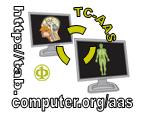Third IEEE International Conference on Self-Adaptive and Self-Organizing Systems
Location: San Francisco, California, September 14-18, 2009
Call for Papers
Important Dates
Paper submission (extended): April 15, 2009
Notification: June 5, 2009
Camera Ready Version of Accepted Papers: June 19 2009
Overview
The aim of the SASO conference series is to provide a forum for laying the foundations of a new principled approach to engineering systems, networks and services based on self-adaptation and self-organization. To this end, the meeting aims to attract participants with different backgrounds, to foster cross-pollination between different research fields, and to expose and discuss innovative theories, frameworks, methodologies, tools, and applications.
The complexity of current and emerging computing systems has led the software engineering, distributed systems and management communities to look for inspiration in diverse fields (e.g., complex systems, artificial intelligence, sociology, and biology) to find new ways of designing and managing networks, systems and services. In this endeavor, self-organization and self-adaptation have emerged as two promising interrelated facets of a paradigm shift.
Self-adaptive systems work in a top down manner. They evaluate their own global behavior and change it when the evaluation indicates that they are not accomplishing what they were intended to do, or when better functionality or performance is possible. A challenge is often to identify how to change specific behaviors to achieve the desired improvement. Self-organizing systems work bottom up. They are composed of a large number of components that interact locally according to typically simple rules. The global behavior of the system emerges from these local interactions. Here, a challenge is often to predict and control the resulting global behavior.
This year's edition is specifically focused at improving our understanding of the properties inherent to self-adaptation and self-organization, a necessary requirement for the effective engineering and building of usable self-adaptive and self-organizing systems. Contributions should present novel theoretical or experimental results, or practical approaches and experiences in building or deploying real-world systems, applications, tools, frameworks, etc. Contributions contrasting different approaches for engineering a given family of systems, or demonstrating the applicability of a certain approach for different systems are particularly encouraged.
Topics
The topics of interest to SASO include, but are not limited to:
- Self-organization
- Self-adaptation
- Other self-* properties (self-management, self-monitoring, self-tuning, self-repair, self-configuration, etc.)
- Theories, frameworks and methods for self-* systems
- Management and control of self-* systems
- Robustness and dependability of self-* systems
- Approaches to engineering self-* systems
- Control of emergent properties in self-* systems
- Biologically, socially, and physically inspired self-* systems
- Applications and experiences with self-* systems
Submission Instructions
All papers should be submitted electronically in PDF format.
Please register as authors and submit your papers using the
SASO 2009 conference management system
All submissions should be 10 pages formatted according to the IEEE Computer Society Press proceedings style guide 8.5" x 11" Two-Column Format. Document templates for submissions can be downloaded here.
The proceedings will be printed and published by IEEE Computer Society Press, and made available on the IEEE digital library.
A separated call for poster submissions will be launched during April 2009.
Review Criteria
Papers should present novel ideas in the topic domains listed above, clearly motivated by problems from current practice or applied research. We expect claims to be substantiated by formal analysis, experimental evaluations, comparative studies, and so on.
Authors are also encouraged to submit application papers. Application papers are expected to provide an indication of the real world relevance of the problem that is solved, including a description of the deployment domain, and some form of evaluation of performance, usability, or superiority to alternative approaches. If the application is still early work in progress, then the authors are expected to provide strong arguments as to why the proposed approach will work in the chosen domain.







